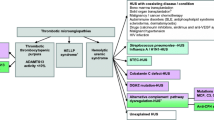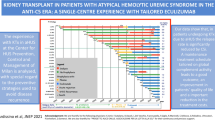Abstract
Haemolytic uraemic syndrome (HUS) is the primary diagnosis of 4.5% of children on chronic renal replacement therapy. Approximately 5% of all HUS cases have an “atypical” or recurrent course. Atypical HUS is an inadequate term that applies to a heterogeneous group of conditions. We describe this group as non-diarrhoeal (D-), non-EHEC (EHEC-) HUS. Patients in the non-diarrhoeal, non-EHEC, relapsing group are much more likely to exhibit severe hypertension, histological findings of arterial as well as arteriolar disease, chronic and end-stage renal failure. In general, these patients have an alarmingly high risk of graft loss from disease recurrence or thrombosis ranging from 60–100%. Family history is crucial, and where family members have relapsing disease, transplantation is a very high risk procedure (recurrence 100%). Patients with D–HUS need very careful consideration before transplantation, including molecular investigation of complement regulators (and von Willebrandt protease (ADAMTS13) activity, although this goes beyond the scope of this review). Guidelines are accessible under https://doi.org/www.espn.ucwm.ac.uk. On no account should live related donation take place unless the risks of graft loss are understood. International collaboration to identify safer ways of transplanting these challenging patients is urgently needed.

Similar content being viewed by others
References
Loirat C, Niaudet P (2003) The risk of recurrent of haemolytic uremic syndrome after renal transplantation in children. Pediatr Nephrol 18:1095–1101
Mellmann A, Bielaszewska M, Zimmerhackl LB, Prager R, Harmsen D, Tschape H, Karch H (2005) Enterohermorrhagic Escherichia coli in human infection: in vivo evolution of a bacterial pathogen. Clin Infect Dis 141:785–792
Gerber A, Karch H, Allerberger F, Verweyen HM, Zimmerhackl LB (2002) Clinical course and the role of shiga toxin-producing Escherichia coli infection in the hemolytic-uremic syndrome in pediatric patients, 1997–2000, in Germany and Austria: a prospective study. J Infect Dis 186:493–500
Zimmerhackl LB (2000) E. coli, antibiotics, and the hemolytic-uremic syndrome. N Engl J Med 342:1990–1991
Chiurchiu C, Ruggenenti P, Remuzzi G (2002) Thrombotic microangiopathy in renal transplantation. Ann Transplant 7:28–33
Noris M, Remuzzi G (2005) Hemolytic uremic syndrome. J Am Soc Nephrol 16:1035–1050
Taylor CM (2001) Hemolytic-uremic syndrome and complement factor H deficiency: clinical aspects. Semin Thromb Hemos 27:185–190
Taylor CM, Chua C, Howie AJ, Risdon RA (2004) Clinico-pathological findings in diarrhoea-negative haemolytic uraemic syndrome. Pediatr Nephrol 19:419–425
Wuerzner R, Zimmerhackl LB (2006) Therapeutic strategies for atypical and recurrent haemolytic uraemic syndrome (HUS). Complement and Kidney Disease, Birkhäuserverlag Basel, Switzerland, pp 149–163
Gerber A, Kirchhoff-Moradpour AH, Obieglo S, Brandis M, Kirschfink M, Zipfel PF, Goodship JA, Zimmerhackl LB (2003) Successful (?) therapy of hemolytic-uremic syndrome with factor H abnormality. Pediatr Nephrol 18:952–955
Warwicker P, Donne RL, Goodship JA, Goodship TH, Howie AJ, Kumararatne DS, Thompson RA, Taylor CM (1999) Familial relapsing haemolytic uraemic syndrome and complement factor H deficiency. Nephrol Dial Transplant 14:1229–1233
Dragon-Durey MA, Fremeaux-Bacchi V, Loirat C, Blouin J, Niaudet P, Deschenes G, Coppo P, Fridman WH, Weiss L (2004) Heterozygous and homozygous factor H deficiencies associated with haemolytic uremic syndrome or membranoproliferative glomerulonephritis: report and genetic analysis of 16 cases. J Am Soc Nephrol 15:787–795
De Cordoba SR, Esparza-Gordillo J, Goicoechea de Jorge E, Lopez-Trascasa M, Sanchez-Corral P (2004) The human complement factor H: functional roles, genetic variations and disease associations. Mol Immunol 41:355–367
https://doi.org/www.klinikum.uni-heidelberg.de/index.php?id=3150
Dragon-Durey MA, Loirat C, Cloarec S, Macher MA, Blouin J, Nivet H, Weiss L, Fridman WH, Fremeaux-Bacchi V (2005) Anti-Factor H autoantibodies associated with atypical hemolytic uremic syndrome. J Am Soc Nephrol 16:555–563
Hebert D, Kim EM, Sibley RK, Mauer MS (1991) Post-transplantation outcome of patients with hemolytic uremic syndrome: update. Pediatr Nephrol 5:162–167
Zimmerhackl LB, Besbas N, Jungraithmayr T, van de Kar N, Karch H, Karpman D, Landau D, Loirat C, Proesmans W, Prufer F, Rizzoni G, Taylor CM (2006) For the European study group for haemolytic uraemic syndrome and related disorders: epidemiology, clinic and pathophysiology of atypical /recurrent haemolytic uraemic syndrome. Semin Thromb Hemost 32:113–120
Pruefer F, Scheiring J, Sautter S, Jensen DB, Treichl R, Wuerzner R, Zimmerhackl LB (2006) Terminal complement complex (C5b-9) in children with recurrent haemolytic uraemic syndrome. Semin Thromb Hemost 32:121–127
Cheong HI, Lee BS, Kang HG, Hahn H, Suh KS, Ha IS, Choi Y (2004) Attempted treatment of factor H deficiency by liver transplantation. Pediatr Nephrol 19:454–458
Remuzzi G, Ruggenenti P, Codazzi D, Noris M, Caprioli J, Locatelli G, Gridelli B (2002) Combined kidney and liver transplantation for familial haemolytic uraemic syndrome. Lancet 359:1671–1672
Bresin E, Daina E, Noris M, Castelletti F, Stefanov R, Hill P, Goodship THJ, Remuzzi G (2006). Outcome of renal transplantation in patients with non-shiga toxin-associated hemolytic uremic syndrome: prognostic significance of genetic background. Clin J Am Soc Nephrol 1:88–99
Remuzzi G, Ruggenenti P, Colledan M, Gridelli B, Bertani A, Bettinaglio P, Bucchioni S, Sonzogni A, Bonanomi E, Sonzogni W, Platt JF, Perico N, Noris M (2005) Haemolytic uraemic syndrome: a fatal outcome after kidney and liver transplantation performed to correct factor H gene mutation. Am J Transplant 5:1146–1150
Kaplan BS, Leonard MB (2000) Autosomal dominant haemolytic uraemic syndrome: variable phenotypes and transplant results. Pediatr Nephrol 14:464–468
Florman S, Benchimol C, Lieberman K, Burrows L, Blomberg JS (2002) Fulminant recurrence of atypical haemolytic uraemic syndrome during a calcineurin inhibitor free immunosuppression regimen. Pediatr Transplant 6:352–355
Artz M, Steenbergen EJ, Hoitsma A, Monnens LAH, Wetzels JFM (2003) Renal transplantation in patients with haemolytic uraemic syndrome: high rate of recurrence and increased incidence of acute rejections. Transplantation 76:821–826
Olie KH, Florquin S, Groothoff JW, Verlaak R, Strain L, Goodship THJ, Weening JJ, Davin JC (2004) Atypical relapse of haemolytic uraemic syndrome after transplantation. Pediatr Nephrol 19:1173–1176
Landau D, Shalev H, Levy-Finer G, Polonsky A, Segev V, Katchko L (2001) Familial haemolytic uraemic syndrome associated with complement factor H deficiency. J Pediatr 138:412–417
Acknowledgments
Members of the ESPN study group [16]: N. Besbas (Turkey), H. Karch (Germany), D. Karpman (Sweden), D. Landau (Israel) , C. Loirat (France), W. Proesmans (Belgium), G. Rizzoni (Italy), C.M. Taylor (United Kingdom), N. van de Kar (Netherlands), L.B. Zimmerhackl (Austria). Contributing physicians and hospitals for the rec HUS study [17]: A. Gerber, Ch. Jacobi (UKK Freiburg), W. Rascher, K. Nüsken (UKK Erlangen), R. Beetz (UKK Mainz), M. Konrad (Inselspital Bern), G. Klaus (UKK Marburg), S. Fründ, M. Bulla (UKK Münster), G. Offner (Kinderklinik MHH, Hannover), H. Fehrenbach, D. Kleinert (KK Memmingen), B. Klare, M. Griebel, S. Martini (Krankenhaus München-Schwabing), B. Tönshoff, S. Weber (UKK Heidelberg), J. Misselwitz, U. John (HKI Jena), B. Hoppe, C. Licht (UKK Köln), M. Bald, M. Holder (Olgahospital Stuttgart), W. Radauer (KK Salzburg), R. Urbanek, E. Balzer, T. Müller (AKH Wien), J. Janda, T. Seemann (UKK Prag), M. Kemper, T. Neuhaus (UKK Zürich), E. Sulyok (Pécs), G. Reusz (UKK Budapest), G. Miltenberger (Innsbruck), P. Zipfel, S. Heinen (Jena), M. Kirschfink (Heidelberg), F. Allerberger (Wien, Innsbruck), H. Karch (Münster). Parts of these data were presented at IPTA meeting in Innsbruck 2005 and appeared in abstract form (Scheiring et al.: Pediatric Transplantation 9: Supplement 6:48, 2005). This analysis was the basis of the thesis of Johanna Scheiring (Medical University Innsbruck). This study was supported by a “Förderstipendium” of the Medical University Innsbruck to Johanna Scheiring. This study was supported by ESPN and APN.
Author information
Authors and Affiliations
Corresponding author
Rights and permissions
About this article
Cite this article
Zimmerhackl, L.B., Scheiring, J., Prüfer, F. et al. Renal transplantation in HUS patients with disorders of complement regulation. Pediatr Nephrol 22, 10–16 (2007). https://doi.org/10.1007/s00467-006-0210-7
Received:
Revised:
Accepted:
Published:
Issue Date:
DOI: https://doi.org/10.1007/s00467-006-0210-7




